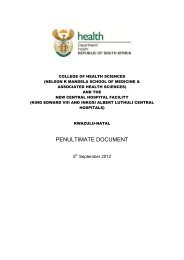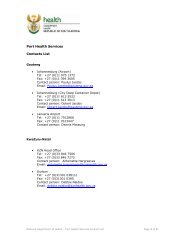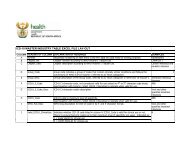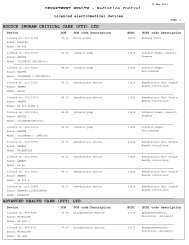National Norms and Standards relating to Environmental Health
National Norms and Standards relating to Environmental Health
National Norms and Standards relating to Environmental Health
You also want an ePaper? Increase the reach of your titles
YUMPU automatically turns print PDFs into web optimized ePapers that Google loves.
1. EH WQMPs should include moni<strong>to</strong>ring of all water sources, including quality issues outside thecatchment areas e.g. rivers, streams, springs <strong>and</strong> waterborne diseases moni<strong>to</strong>ring.2. Water source mapping must be done <strong>and</strong> should include infrastructure coverage, water availability,functionality, number of people crowding per facility <strong>and</strong> record keeping for any health risks that mayoccur per water source; followed by water quality moni<strong>to</strong>ring.3. Sampling should be focused on water supplies that are likely <strong>to</strong> pose risk <strong>to</strong> human health; wherecredible water quality data is available from other sources (e.g. WSAs/BDS/GDS) re-sampling shouldbe avoided <strong>to</strong> avoid duplication of efforts.4. The programme must include the moni<strong>to</strong>ring of all health risk determining parameters in terms ofmicrobiological, chemical <strong>and</strong> physical qualities, as well as waterborne disease surveillance, <strong>to</strong>ensure overall quality of water fit for human consumption.5. Sampling should only be conducted from pre-determined representative sampling points or prioritizedfocus areas, as outlined in the WQM strategies, unless in cases of emergencies.6. Water supply should be moni<strong>to</strong>red in accordance <strong>to</strong> WQMPs for the purpose of quality assurance <strong>and</strong><strong>to</strong> satisfy a quest <strong>to</strong> ensure optimum public health.7. WQMPs should be strictly followed <strong>and</strong> implemented; hence proper water quality moni<strong>to</strong>ring recordsshould be kept at all times.8. Drinking water quality results must comply with the prescribed limits as specified in the SANS 241 fordrinking water.9. Only SANAS 17025:2005 accredited labora<strong>to</strong>ries or Department of Water Affairs (DWA)-approvedlabora<strong>to</strong>ries per method of analysis must be used for analysis of water samples <strong>to</strong> ensure credibleresults.10. Mapping of water sources <strong>and</strong> mapping of critical water points that need <strong>to</strong> be moni<strong>to</strong>red <strong>and</strong>reviewed must be conducted on yearly basis/annually <strong>to</strong> track changes in water supply <strong>and</strong> ofmoni<strong>to</strong>ring of those water sources.11. WSAs, EHPs <strong>and</strong> other institutions responsible for water quality moni<strong>to</strong>ring should only use theSANAS 17025:2005 accredited labora<strong>to</strong>ries or Department of Water Affairs (DWA)-approvedlabora<strong>to</strong>ries per method of analysis for analysis of samples, <strong>to</strong> ensure credible results.12. EHPs should familiarize themselves with the DWA Incentive-Based Regulation - Blue Drop <strong>and</strong>Green Drop criteria, as well as the Blue-Drop <strong>and</strong> Green Drop reports as a fundamental guide forstrengthening environmental health interventions <strong>and</strong> <strong>to</strong> avoid duplication of efforts in sampling. Dataaccessible from the BDS/GDS can be utilized.13. EHPs must raise awareness <strong>and</strong> educate communities on proper <strong>and</strong> safe water usage, the dangersof untreated water sources <strong>and</strong> health <strong>and</strong> hygiene education related <strong>to</strong> water supply <strong>and</strong> sanitation.SAMPLING OF WATER SOURCESTable 1: Recommended sampling frequencies.MINIMUM PER POINTRECOMMENDED PER POINTSAMPLING POINTNumber ofsamples peryearSamplingfrequencyNumber ifsamples peryearSamplingfrequencyRiver/stream/spring/dugwell4 3-monthly 26 2-weeklyDam 2 6-monthly 12 2-monthlyBorehole 1 - 2 6-monthlyTreatment works 4 3-monthly 12/52/365 Monthly/weekly/dailyPoint of use (schools,prisons, health facilitiesetc)Waterborne diseases(cholera, bilharzias)Commercial <strong>and</strong>recreational water(swimming pools, spa,4 3-monthly 12/52/365 Monthly/weekly/daily4 3-monthly 12 3-monthly2 3-monthly 12 MonthlyDOH. <strong>Norms</strong> <strong>and</strong> st<strong>and</strong>ards for environmental health in South Africa Feb 2013 96


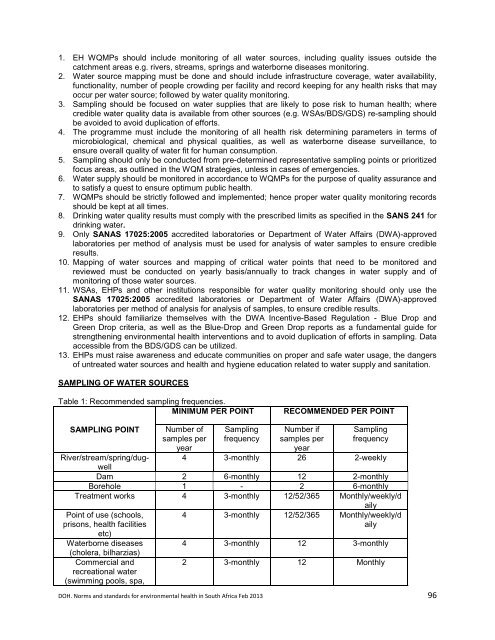
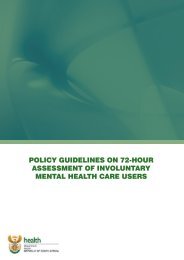

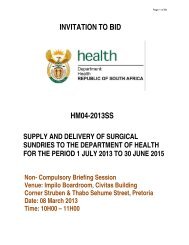
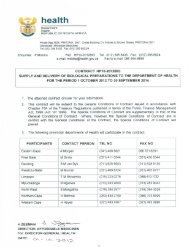
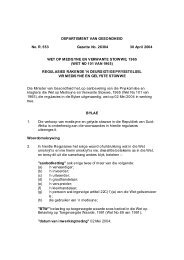
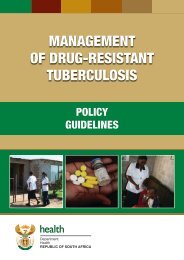
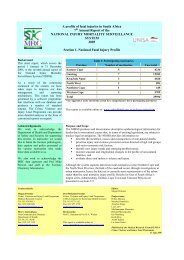
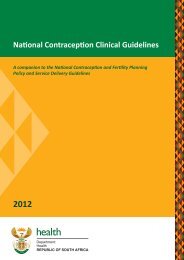
![A monograph of the management of postpartum haemorrhage [2011]](https://img.yumpu.com/15578784/1/184x260/a-monograph-of-the-management-of-postpartum-haemorrhage-2011.jpg?quality=85)
